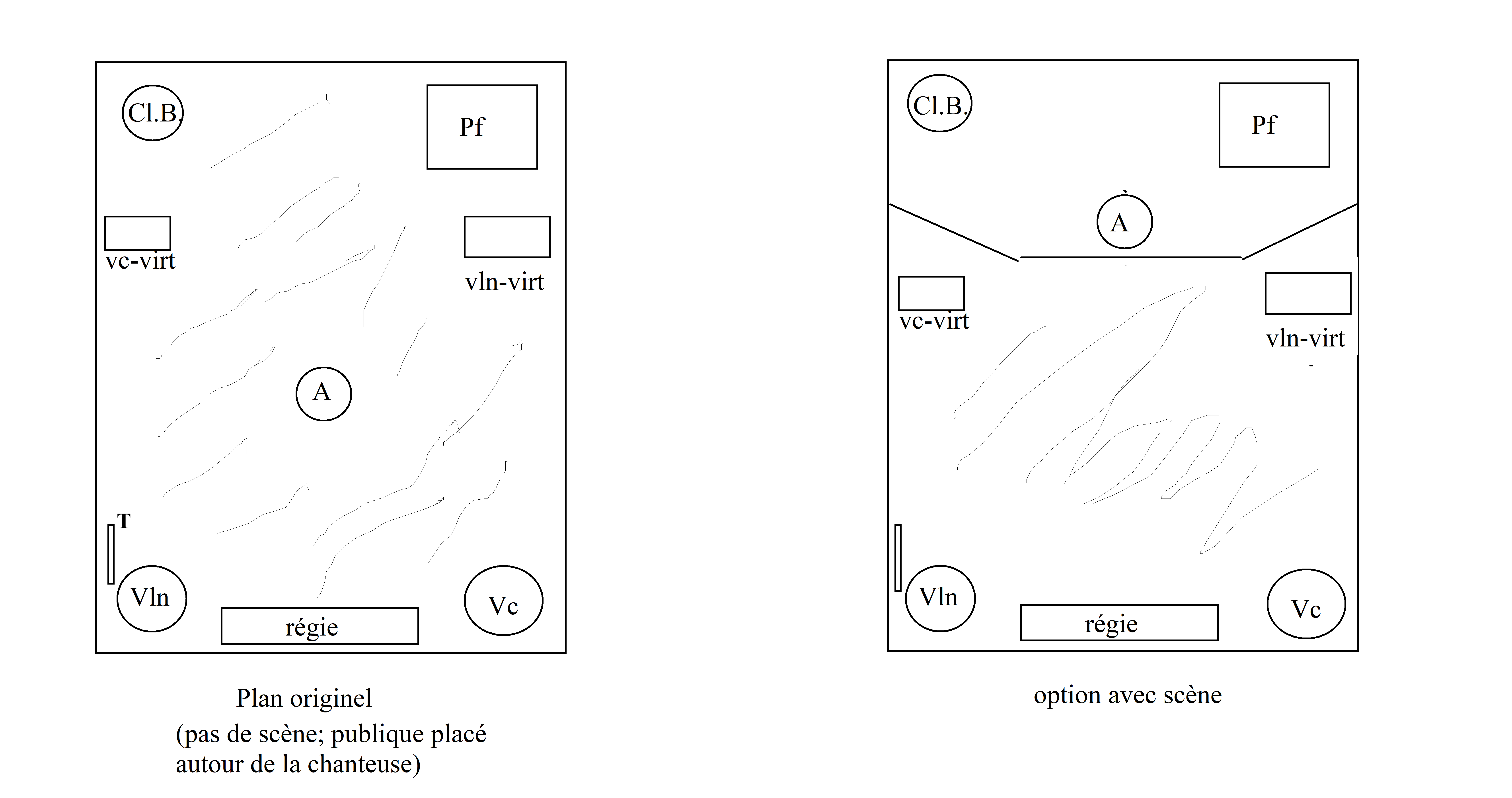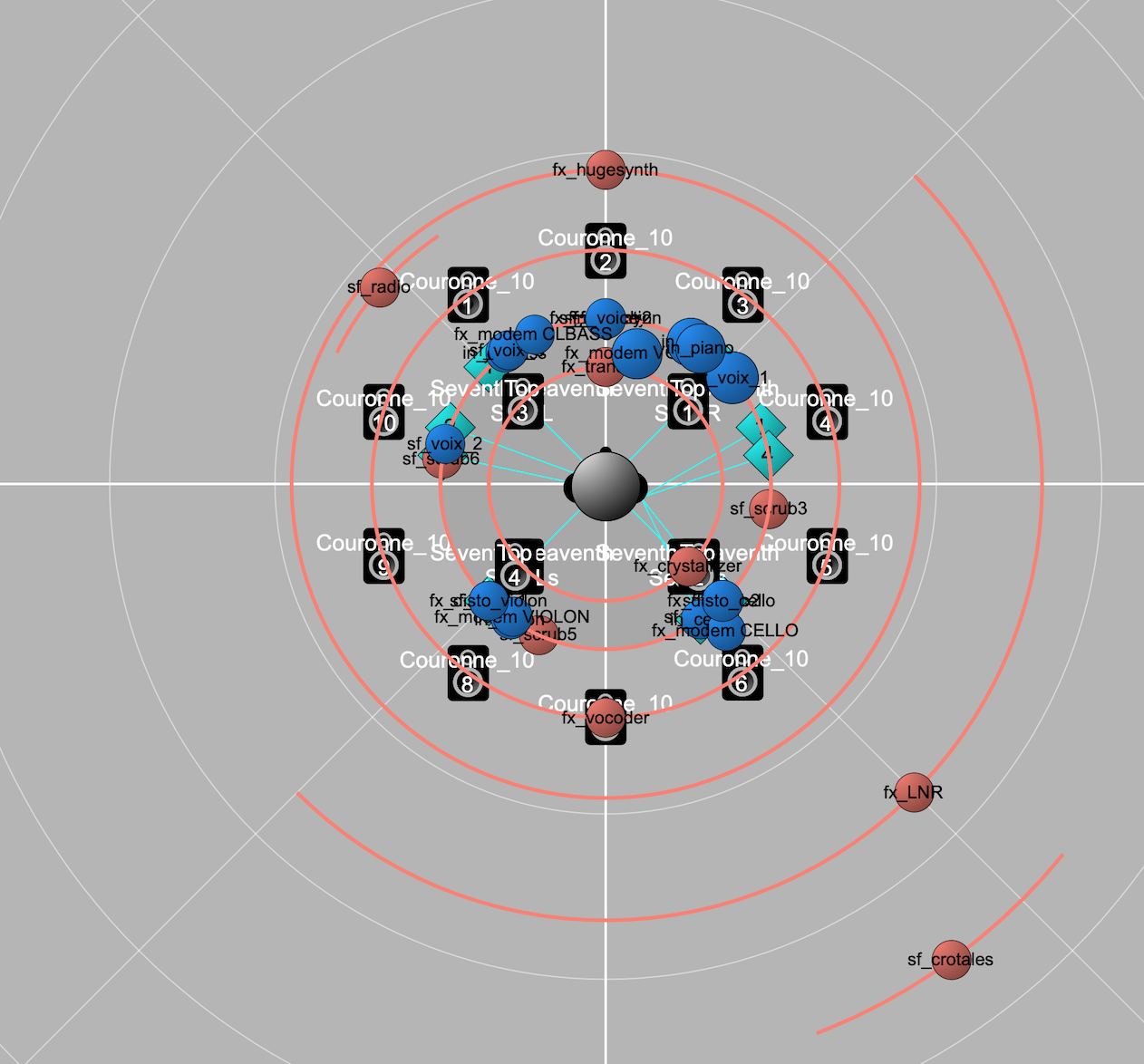Table of contents
- Version documentalist
- Version realisation
- Detailed staff
- Electronic equipment list
- Work related information
- Useful links on Brahms
- Instructions
- 1. Audio setup
- 2. Loudspeaker setup
- 3. Midi setup
- 4. Software installation
- 4 bis. Sinegen Electronic Piano Kit
- 4 ter. Timer
- 4 quater. Virtual instruments
- 5. Patch presentation
- a) Max/MSP patches
- b) DSP Status Options (Fs, IO vs, S vs, Overdrive, Audio Interrupt, Vector Optimization)
- 6. Initialization routine
- 7. System calibration and tests
- 8. Performance notes
- 9. Extra Equipment required
- Program note
Performance date: 20 mai 2021 - First performance
Documentation date: 10 septembre 2021
Version state
Valid
Validation date: 20 octobre 2021
Executions dates of this version
- 20 mai 2021, Theater am Lend
- 17 juin 2021, Théâtre de Gennevilliers
Version documentalist
- demoulin (Etienne.Demoulin@ircam.fr)
Version realisation
- Etienne Démoulin (Computer Music Designer)
Version length
40 mnNo other version available
Detailed staff
- soliste : soprano
- clarinette basse, percussionniste, piano, violon, violoncelle
Channel details
- Number of input channel : 6
- Number of output channel : 14
Electronic equipment list
Computer Music Equipment
-
1 Raspberry Pi - Computers
(Raspberry)
-
2 MacBook Pro - Apple Laptops
(Apple)
-
1 iPad - Tablets
(Apple)
-
1 Wifi router - Wifi Access Point
that covers all the venue -
1 Max 8 - Max
(Cycling74)
-
1 Ircam Spat - Library
(Ircam)
-
1 Digiface Dante - Sound Board
(RME)
-
2 MIDI Mixer - MIDI Mixer
2 BCF2000 or Asparion D400 + 2 fader bank -
3 Footswitch / Sustain Pedal - Footswitch / Sustain Pedal
Audio Equipment
-
14 Loudspeaker - Loudspeakers
-
10 Dayton - Transducers
(Dayton)
(3 small / 3 mid / 4 big) and amps.
Work related information
Premiere
- 19 mai 2021, Autriche, Graz, Theater am Lend
- 17 juin 2021, France Gennevilliers, T2G Théâtre de Gennevilliers, ManiFeste 2021
Publisher :
- Suvini Zerboni
Realisation
- Étienne Démoulin
Work length
- entre 40 mn et 50 mn
Useful links on Brahms
- Ariadne monodrame-installation pour voix, cinq performers et électronique live (2021), 40mn
- Maurizio Azzan
| File | Author(s) | Comment | |
|---|---|---|---|
| Download [2,2 Mio] | Other Sinegen Source Documentation | Etienne Démoulin | |
| Download [5,9 Gio] | Other Sinegen - Image Disque | Etienne Démoulin | |
| Download [2,6 Gio] | All-in-one Main patch | Etienne Démoulin |
Instructions
1. Audio setup
Welcome to the great world of Ariadne.
Be careful about the particular stage setup of this piece.
2. Loudspeaker setup
In cause of this particular stage setup, loudspeakers should be adapted for each venue. You will need : a ring of loudspeaker and a “spot” of loudspeaker above the singer.
For the creation we had a ring of 10 loudspeakers and 4 loudspeakers above the singer.
Please adapt the ring of loudspeaker according to the size of the venue
3. Midi setup
ON STAGE :
Cello and Violin player have a MIDI pedal. They trigger events in both interludes.
ON COMPUTER :
List of faders you should play with (movements are written in the score)
| MIDI number | OSC track number | Explicit name |
|---|---|---|
| 0 | /track/4 | sf_voix |
| 1 | /track/7 | fx_modem |
| 2 | /stereo/2 | fx_LNR |
| 3 | /stereo/3 | fx_crystallizer |
| 4 | /stereo/4 | fx_hugesynth |
| 5 | /stereo/7 | sf_scrubs |
| 6 | /stereo/13 | sf_bomb |
| 7 | /stereo/14 | sf_crotales |
| 8 | /stereo/15 | sf_grave |
| 9 | /stereo/16 | sf_radio |
| 10 | /stereo/19 | fx_transrev |
| 11 | /stereo/17 | sf_dummy |
| 12 | /stereo/1 | sf_dummy2 |
| 13 | /bus/7 | master couronne |
| 14 | /bus/2 | master transducer |
| 15 | /bus/8 | reverb |
| 16 (optionnal) | /track/12 | fx_disto |
4. Software installation
Copy the folder _MAIN_ARIADNE_AZZAN into your desktop.
You will have to launch 2 separate Max applications at the same time :
Select Max 8 in your Applications folder
Duplicate it, and rename the first one Max, and the second one, Max2.
Then launch each one and select the whole _MAIN_ARIADNE_AZZAN folder into Files Preferences.
Close everything and launch ARIADNE_AZZAN.sh
Maybe you will have to refresh permissions for this script :
Copy ARIADNE_AZZAN.sh into your desktop
Launch a terminal and type the command : sudo chmod +x ~/Desktop/ARIADNE_AZZAN.sh
4 bis. Sinegen Electronic Piano Kit
The electronic for the piano part is triggered by an autonomous system based on a Raspberry Pi.
The goal is to output sine waves into transducers. Triggers are made with MIDI pedal directly connected to the PI.
This system is called Sinegen Electronic Piano Kit and hosted at IRCAM.
In case of this box is lost, you will find hardware and software documentation in the sinegen_source_code to build it.
Overwise, just plug the box, connect an iPad to the sinegen WIFI network. The password is sinegen2020. Open Safari and type : sine.local
Then press the pedal and follow the score !
4 ter. Timer
Every musician needs a timer to follow the score. They usually uses smartphones.
Everybody has to be connected to the same WIFI network (the network should cover all the venue)
Plug your computer into the WIFI router with a RJ45 cable.
To access the timer, musicians have to connect your computer IP:8080
Timer server start with the 1!INIT button.
The first time you launch the patch you should click on script npm install box into [p TIMER]
4 quater. Virtual instruments
Nobody plays virtual instruments. 2 Transducers are put on them, they have a loudspeaker function.
5. Patch presentation
a) Max/MSP patches
ARIADNE_Azzan patch
[p ADC] is the input for Real Time electronic.
Please adjust the input level with the sound engineer according to the references.
Example : Violon : “please play the end of your interlude” —> the level has to reach the line.
[p DSP_MAIN] is the main matrix for sound files and real time electronic
[p DSP_TRANSDUCER] is the special processing for transducers
[p SCORE] host the antescofo score
[p SPAT] control the messages for Panoramix automations
[p CONFIG] is general configuration stuff
[p TIMER] is configuration for the timer
[p MIDI] is the midi configuration. Please see the specific section.
ARIADNE_Azzan_Spat patch:
This is basically Panoramix.
Please refer to the official documentation.
You have to adjust Couronne_10 and HOA_reverb_14 bus according to your venue configuration.
b) DSP Status Options (Fs, IO vs, S vs, Overdrive, Audio Interrupt, Vector Optimization)
2 instances should have the following settings : 44.1kHz / IO 256 / VS 256 / OVERDRIVE ON
6. Initialization routine
- Open ARIADNE_AZZAN.sh script.
In Panoramix :
2. Select Audio Input : BlackHole
3. Select Audio Output : your Soundcard
4. Active audio
In Main Patch
5. Press the 1! INIT button
6. Load the Panoramix session in config/panoramix_manifeste2021.txt
7. Select Audio Input : your Soundcard
8. Select Audio Output : BlackHole
9. Active Audio
10. Check fader with your MIDI interface and Panoramix
11. Check timer with musicians
12. Check MIDI Pedal with cellist and violinist
7. System calibration and tests
Please adjust ADC input level (see below)
Please manually start the timer and check that it works with every musician.
Please manually check the Violin and Cello MIDI pedals.
8. Performance notes
You need to trigger all cues from the computer except for both interludes.
9. Extra Equipment required
- SINEGEN ELECTRONIC PIANO KIT
- smartphones for the musicians’ timers
- 1 violin, 1 cello and 1 metallic tube for virtual instrument (please talk with regissor)
© IRCAM

This documentation is licensed under a Creative Commons Attribution-NonCommercial-NoDerivatives 4.0 International License.
Program note
*« Thésée n’est pas cruel parce qu’il abandonne Ariane. […] Non, Thésée est cruel parce qu’il abandonne Ariane sur l’île de Naxos. […] Une simple plage fouettée par des vagues rugissantes, Un lieu abstrait où seules bougent les algues. C’est l’île où personne ne vit, Le lieu où les obsessions tournent en rond, sans échappatoire. Un étalage permanent de mort. C’est un lieu pour l’âme.* R. Calasso, *Les noces de Cadmus et Harmonie* L’histoire d’Ariadne, abandonnée par Thésée sur l’île désertée de Naxos, après avoir quitté pour lui le foyer familial, est l’un des plus fameux mythes de la Grèce antique. Si l’une de ses versions les plus connues est celle de l’arrivée de Bacchus sur l’île et son mariage subséquent avec Ariadne, la plupart d’entre elles se soldent sur sa mort, provoquée par l’égoïsme de son amant. Qu’elle se pende ou meurt en couche – des oeuvres de Thésée –, qu’elle soit tuée au cours d’une bataille ou monte au ciel après avoir été forcée à suivre Bacchus, Ariadne est une victime sans défense, sous le regard de milliers de dieux qui peuplent la Terre et les Mers. Des dieux qui observent le spectacle de cette femme pleurant sur les rives de Naxos comme ils considéreraient les vains efforts d’un insecte enfermé dans une bouteille : elle ne peut que se soumettre au destin, parce qu’ils n’en ont rien à faire. Son désespoir, sur cette île déserte, gardée de toutes parts par les flots, est le symbole môme de la solitude : un lieu où l’obsession tourne et tourne sur elle-même, sans autre issue que la mort. Ariadne est donc le récit d’une absence par abandon. Une femme naufragée sur une île déserte tente de rassembler toutes les pièces du puzzle de sa vie. Des bribes de souvenirs se détachent d’un brouillard dense dans lequel se mêlent différentes versions du mythe, avec pour seul invariant la voix d’Ariadne à laquelle personne ne prête attention, passée inaperçue du regard négligent des dieux. La protagoniste, dans un ultime effort d’échapper à sa condition, tente de se retrouver elle-même, afin de retracer une vérité qui, en dépit de la variété des légendes, pourrait mettre un terme à ses souffrances. *Ariadne* est un monodrame pour voix, instruments spatialisés et électroniques, pensé comme une installation immersive, qui commence avant même que le public ne pénètre dans la salle de concert, de sorte que l’espace de la performance, les instruments, la voix et le public lui-même s’étend des confins du foyer et de ses rumeurs, jusqu’aux voix des différents destins d’Ariadne encagés dans les instruments augmentés, disséminés dans la salle comme autant de récifs dans la mer, et jusqu’au public, qui figure l’onde emprisonnant Ariadne en même temps que l’indifférence des dieux à sa peine. Au moment même où le public pénètre dans la salle de concert, la musique commence à prendre forme, peu à peu, transformant les bruits de fond en sons, au moyen de l’électronique en temps réel, dans un processus qui brouille les frontières entre performance et audience, laquelle devient un élément actif du dispositif.Maurizio Azzan & Daniele Bellomi, note de programme du concert ManiFeste du 17 juin 2021 au T2G.
Version documentation creation date: 10 septembre 2021 15:22, update date: 20 octobre 2021 16:48